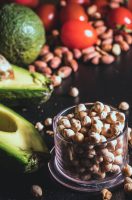What is Osteoporosis?
Osteoporosis is a disease in which bones become thin (lose density) and weaken (lose structural integrity). It is estimated that 10 million Americans have osteoporosis and 18 million more have low bone mass, increasing their susceptibility of spine, wrist and hip fractures. (National Institute of Health 2010) Osteoporosis is considered to be more common among the elderly; however, the disease may strike at any age. (Bauman 2012) Often called the “silent disease”, many Americans do not know they are at risk because they have no symptoms until fractures occur. According to the NIH (2010) osteoporosis is the leading cause in 1.5 million fractures annually. (Bauman, 2012)
Studies indicate that 80% of people affected with osteoporosis are women. Of those, many are post-menopausal. (NIH, 2010; Colbin, 2009, pp.19-20)
Postmenopausal osteoporosis is one of two distinct types of osteoporosis otherwise know as Type I, which occurs naturally with the process of age due to the decline in a woman’s estrogen- this can be as little as 5% bone loss or up to as high as 40% ten years after menopause.
Senille osteoporosis or Type II tends to effect individuals in the seventh decade of life due to lower absorption of calcium in the GI tract and a decline of the hormone calcitonin, which helps keep calcium in the bones. (Colbin, 2009, pp.19-20)
As stated above, individuals of varying age may be affected by osteoporosis so it is important to keep certain risk factors in mind. Risk factors may include: family history, lack of exercise (especially weight bearing), smoking, excess alcohol and caffeine consumption, being too thin or underweight, not having sufficient bone mass around the age of thirty, and certain diseases such as Chron’s, celiac, kidney, and hyperthyroidism.
In addition, Annemarie Colbin, Ph.D. states (2009, pp. 21-22) that the modern diet plays a significant role in osteoporosis today. Excess consumption of certain foods such as animal protein, vegetables from the nightshade family (potatoes, tomatoes, peppers and eggplant), damaging fats, as well as refined sugars and flours produce far too much acidity in the tissue thus robbing our bodies of essential nutrient stores.
3 Key Nutrients:
- Magnesium
- Zinc
- Omega 3 Fats
Magnesium is a critically important cofactor involved in more than 300 enzyme reactions throughout the human body. One if it’s functions is to stimulate calcium absorption into the bones. For this reason, magnesium may be just as important as calcium to prevent and or treat osteoporosis. (Colbin, 2009, p.39)
Food Sources of Magnesium:
(Milligrams per 100 grams (3 1/2 oz) edible portion)
- Kelp=760
- Wheat Bran= 490
- Almonds= 270
- Tofu= 111
- Beet Greens= 106
- Spinach= 88
- Dried Figs= 71
- Avocado= 45
- Shrimp= 51
The recommended daily intake (RDI) for magnesium is 350 mg for adult males and 300 mg for adult females. It is best taken in the chelated form along with 25-50 mg of B6. Magnesium taken in doses of 600 mg or more may result in diarrhea. Toxicity can prove to have more severe symptoms such as drowsiness, lethargy and weakness. (M. Murray. N.D. 2005)
Zinc is yet another critical cofactor in many enzymatic reactions in the body. Zinc is vitally important for protein synthesis as well as wound healing, immune function and bone structure. (Clinical Nutrition Second Edition). Zinc also enhances the action of vitamin D in the body, which in turn aids in the absorption of calcium from the small intestines. (Bauman 2012)
Food Sources of Zinc:
(Milligrams per 100 grams (3 1/2 oz) edible portion)
- Oysters= 148.7
- Pumpkin seeds= 7.5
- Ginger root= 6.8
- Egg yolk= 3.5
- Whole wheat= 3.2
- Chicken= 2.6
- Tuna= 1.7
- Walnuts= 3.0
- Green peas=1.6
The RDI for the general preventative and therapeutic use of zinc in the form of picolate or orotate is 15- 20 mg daily. Zinc is best tolerated when taken with food. It is important to note, zinc and copper intake must be in balance 15:1 due to competition for the receptor cites.
Fats essential fatty acids such as gamma linolenic acid (GLA) and eicosapentaenoic acid (EPA) help maintain or increase bone mass. Studies show they also diminish calcium loss in urine, enhance calcium absorption and improve bone strength. (Colbin, 2009 p.42)
Food Sources of EFAs
(Milligrams per 100 grams (3 1/2 oz) edible portion)
Omega 6 fatty acids
Omega 3 fatty acids
- Borage oil=GLA
- Black currant=GLA
- Safflower oil=LA
- Corn oil= LA
- Walnut oil=LA
- Fish oil=EPA & DHA
- Flax oil=ALA
- Pumpkin= ALA
- Chia=ALA
Recommendations for EPA and DHA should be 650 mg daily, 2.22 g/day of alpha-linolenic acid and 4.44 g/day of linoleic acid. (NIH)
Ratios of omega 6 to omega 3 should be about 3:1.
Additional Foods, Herbs and Supplements to Manage Osteoporosis:
Boron
- Is essential in the activation of estrogen and vitamin D- both of which are important in maintaining bone structure.
- RDA has not yet been determined in boron. Requirement may vary between 1 to 6 mg daily.
- Dried fruits and nuts as well as vegetables are a good source of boron.
Vitamin D
- Stimulates the absorption of calcium.
- Recommended intake- 2000IU daily-although best obtained through sunlight.
- Vitamin D is fat-soluble. Sources of good fats in the diet would include, wild salmon and mackerel, cod liver oil and leafy green vegetables.
Black cohosh
- Daily dosage range: 40-80 mg per day. Tablets should contain 1 mg of 27- deoxyactein.
- Beneficial in balancing hormones and maintaining bone health
Vitamin K1
- Converts inactive osteocalcin (the major noncollagen protein in bone) to its active form
- Very low blood vitamin K1 is found in individuals with OP fractures.
- Riches food sources: dark leafy greens, broccoli, green tea, cabbage
- Good sources: oats, asparagus, green peas, whole wheat
Resources:
The Encyclopedia of Healing Foods M. Murray N.D. 2005
http://www.mercola.com/beef/omega3_oil.htm
Clinical Nutrition A Functional Approach 2nd Edition 2004
Therapeutic Nutrition Part One Ed Bauman, M.Ed., Ph.D. & Jodi Friedlander, N.C
The Clinicians’ Handbook of Natural Medicine Second Edition 2008



